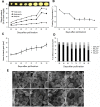Identification and expression analysis of starch branching enzymes involved in starch synthesis during the development of chestnut (Castanea mollissima Blume) cotyledons
- PMID: 28542293
- PMCID: PMC5441625
- DOI: 10.1371/journal.pone.0177792
Identification and expression analysis of starch branching enzymes involved in starch synthesis during the development of chestnut (Castanea mollissima Blume) cotyledons
Abstract
Chinese chestnut (Castanea mollissima Blume) is native to China and distributes widely in arid and semi-arid mountain area with barren soil. As a perennial crop, chestnut is an alternative food source and acts as an important commercial nut tree in China. Starch is the major metabolite in nuts, accounting for 46 ~ 64% of the chestnut dry weight. The accumulation of total starch and amylopectin showed a similar increasing trend during the development of nut. Amylopectin contributed up to 76% of the total starch content at 80 days after pollination (DAP). The increase of total starch mainly results from amylopectin synthesis. Among genes associated with starch biosynthesis, CmSBEs (starch branching enzyme) showed significant increase during nut development. Two starch branching enzyme isoforms, CmSBE I and CmSBE II, were identified from chestnut cotyledon using zymogram analysis. CmSBE I and CmSBE II showed similar patterns of expression during nut development. The accumulations of CmSBE transcripts and proteins in developing cotyledons were characterized. The expressions of two CmSBE genes increased from 64 DAP and reached the highest levels at 77 DAP, and SBE activity reached its peak at 74 DAP. These results suggested that the CmSBE enzymes mainly contributed to amylopectin synthesis and influenced the amylopectin content in the developing cotyledon, which would be beneficial to chestnut germplasm selection and breeding.
Conflict of interest statement
Figures




References
-
- Smith AM, Denyer K, Martin C. The synthesis of the starch granule. Annu Rev Plant Physiol Plant Mol Biol. 1997; 48: 67–87. doi: 10.1146/annurev.arplant.48.1.67 - DOI - PubMed
-
- Diego F, Kathleen GH, Shelley J. Starch characteristics of modern and heirloom potato cultivars. Am J Potato Res. 2013;
-
- Botticella E, Sestili F, Lafiandra D. Characterization of SBEIIa homoeologous genes in bread wheat. Mol Genet Genomics. 2012; 287: 515–524. doi: 10.1007/s00438-012-0694-8 - DOI - PubMed
-
- Jiang L, Yu X, Qi X, Yu Q, Deng S, Bai B, et al. Multigene engineering of starch biosynthesis in maize endosperm increases the total starch content and the proportion of amylose. Transgenic Res. 2013; 22, 1133–1142. doi: 10.1007/s11248-013-9717-4 - DOI - PubMed
-
- Syahariza ZA, Sar S, Hasjim J, Tizzotti MJ, Gilbert RG. The importance of amylose and amylopectin fine structures for starch digestibility in cooked rice grains. Food Chem. 2013; 136: 742–749. doi: 10.1016/j.foodchem.2012.08.053 - DOI - PubMed
MeSH terms
Substances
LinkOut - more resources
Full Text Sources
Other Literature Sources
Research Materials

